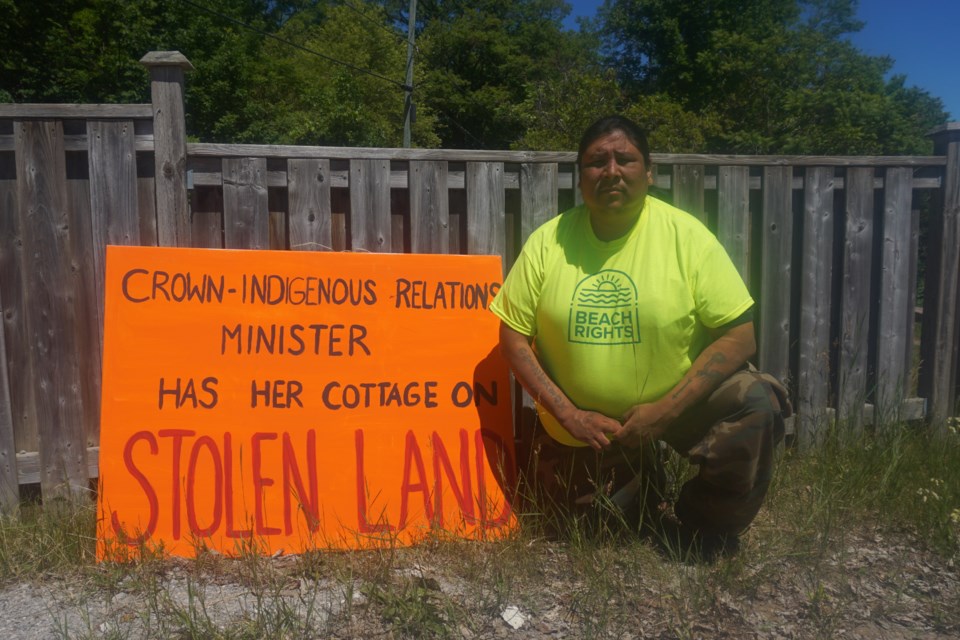A local First Nations activist has come out against Tiny Township’s plan to build a new municipal building.
Johnny Hawke says Tiny council needs to set aside its plans to ensure the health of ice age grass (forked three-awned grass) since the protected grass species is growing adjacent to the proposed site for the new building.
“My community had to reconsider the proposed site of two key infrastructure plans, our community centre as well as a proposed public works facility on a field purchased on Cedar Point Road in Tiny Township because of this ice age grass.” says the Christian Island man, who was involved in the blockade to halt construction of the North Simcoe landfill (Dump Site 41) to protect the Alliston Aquifer in 2009.
Paul Bell, a forest entomologist, says ice age grass has been identified and documented as growing directly adjacent to and perhaps on the proposed construction site located just north of the Huronia Regional Airport.
Bell says an environmental assessment and detailed species-at-risk study must be thoroughly completed before any shovel is put into the ground at the proposed site.
“A similar situation occurred on Christian Island,” Bell says. “A planned construction of a community centre had to be stopped to have its footprint altered. The ice age grass was relocated to a nearby suitable habitat.”
Ice age grass (Aristida basiramea) is considered a critically endangered species in Canada.
“Like the eastern meadowlark, butternut (tree), grass pickerel, Monarch butterfly or Blanding's turtle, they are all species at risk in Canada,” Bell says.
“All endangered species are protected by law against harm, harassment, capturing or threat.”
The federal Species at Risk Act is in place to allow the government to provide legal protection of wildlife species and the conservation of their biological diversity while ensuring Canadian indigenous species, subspecies and distinct populations are protected from becoming extirpated or extinct, to provide for the recovery of endangered or threatened species.
The forked three-awned grass stands about 15 centimetres tall and “is quite unremarkable,” according to a Parks Canada document.
“The people of the Beausoleil First Nation had lived with the plant for thousands of years and they didn’t distinguish it from other grasses," Parks Canada notes. "But now the First Nation residents are active stewards for this endangered species.”
Hawke also cites and raises Treaty concerns relating to this specific issue and claims the township is occupying lands that his people were never compensated for and that Tiny needs to be environmental stewards of his "Nation's illegally occupied" territory.
“We never have been properly compensated in the 1795 Penetanguishene Purchase Treaty # 5, The Lakes Simcoe Purchase of 1815, Treaty # 16 and the Lake Simcoe-Nottawasaga Treaty# 18 which encompass 250,000 Acres that Simcoe County unlawfully occupies," Hawke says, noting the Chippewa Tri Countil (comprised of Beausoleil, Georgina Island and Rama First Nations) submitted this "outstanding injustice" to Canada’s Specific Claims Branch in 1990, but Canada refused to accept this matter "at that time."
“In the 2018 Williams Treaty Settlement, Ontario and Canada ensure they will renew ongoing treaty relationship and foster reconciliation and understanding. Allowing a municipality to illegally occupy our lands and be unaccountable to the Federal Species Act Risk Act violates this 2018 Agreement and is discriminatory action where we’re made to follow but Tiny Council is exempt."
Hawke says he plans to organize "a peaceful educational and arts action" to raise awareness on these issues, but did not disclose what his plans might be.
“We are in the era of Truth and Reconciliation which goes beyond tokenism and wearing an orange shirt for one day in September,” says Hawke, who calls on Tiny residents to support and work in unity with him to help "stop the build."
